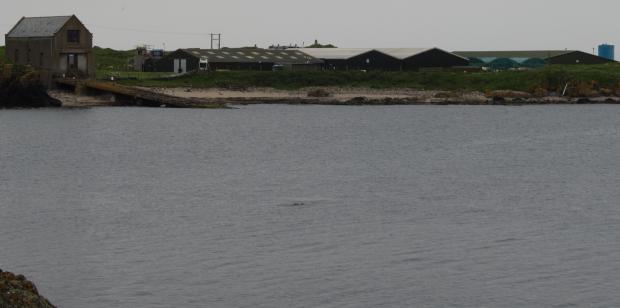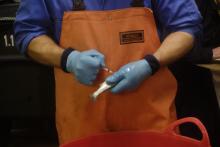
Developing a vaccine against sea lice
Aquaculture is a rapidly growing industry, and an increasingly profitable one. As global food supplies continue to dwindle, there is a need for cost-effective, large scale production of nutrient-rich food sources. Large scale production of fish through aquaculture has become more and more common in recent years, and offers a method of supplying the world’s growing population with a protein source for years to come. One drawback to fish farming on this scale is the susceptibility of farmed populations to disease. Fish, and indeed shellfish, are susceptible to a wide range of viral, bacterial and parasitic diseases; and the treatment and prevention of these diseases in the aquaculture industry is an extremely costly business. With some of the current control methods proving ineffective, there is a need for scientists to develop alternative control methods, such as vaccines.
In Scotland, the most economically important farmed fish is Atlantic salmon (Salmo salar), with an estimated industry value of £677 million in 2013 (Scottish Salmon Producers Assoc.). Salmon are affected by many disease-causing pathogens, but the most publicised is probably the sea louse, with Lepeophtheirus salmonis being the most problematic species in the UK. Sea lice are small, ectoparasitic crustaceans which attach to the skin of salmon and feed on mucus, skin and blood. This causes physical damage to the fish, and can lead to secondary bacterial infections. Whilst infestations are not usually fatal, the cost of treating these parasites is estimated at around £25 million each year in Scotland alone, making sea lice control a priority for the salmon farming industry.

What are the current control methods?
The majority of sea lice infestations are typically controlled by drug treatments. However, over the last 15-20 years, the lice have started to develop resistance to most of the commercially available treatments. This “drug resistance” develops in a similar way as bacterial resistance to anti-biotics (e.g. in superbugs like MRSA). Over time, these anti-parasitic drugs have been used so extensively that the parasites themselves are evolving to become resistant to these treatments. This means that fish farmers are struggling to deal with sea louse infestations, and are desperately in need of alternative control measures.
What alternatives are available?
The rapid increase in resistance to anti-parasitic drug treatments in sea lice has led researchers to investigate other avenues for control of this parasite. One alternative is the use of ballan wrasse. Ballan wrasse naturally predate sea lice, so when they are introduced into sea cages they will nibble the lice off of the resident salmon. This practice has proven to be very successful in lab trials, and is now being utilised by some farms both in Scotland and Norway, another major producer of Atlantic salmon.
Another alternative control method is the use of in-feed immunostimulatory treatments to boost the immune response of fish. Some in-feed treatments, such as cytosine-phosphate-guanine oligodeoxynucleotides (CpG ODNs), can reduce the number of lice on fish (Covello et al, 2012). These synthetic compounds act by mimicking natural pathogens, and stimulate the fish’s immune system. This can help fish to fight off sea lice through a natural immune response. Research in this area is still in its early stages, but initial results suggest this approach could be used as part of an integrated pest management scheme to control sea lice in Scotland and further afield.

Is vaccination a possibility?
In aquaculture, vaccination has been used to successfully control some bacterial diseases of fish, such as furunculosis and vibriosis; but as yet there are no commercial vaccines for the control of parasites. Vaccinating against parasites is generally more complicated than vaccinating against a bacterium or virus, as parasites are more complex organisms. For many bacterial and viral diseases, it is possible to inject an attenuated form of the pathogen into the host to induce a protective antibody response; however this is not possible with a parasite. Instead, either a mixture of proteins or a single protein derived from the parasite is typically used as a vaccine antigen. The problem is finding the right protein, or combination of proteins.
Since there are no vaccines available to protect against aquatic parasites, researchers are using successful terrestrial parasite vaccines as a model for sea louse vaccine development. One of the most successful anti-parasite vaccines to date is the TickGARD™ vaccine, which utilises a gut-derived protein from ticks to protect cattle from infestation (Willadsen et al, 1995). Several vaccine trials using sea louse homologues of tick antigens have been performed with some success.
The ability of the sea louse to immunomodulate its host offers another source of potential vaccine candidates. It is believed that, like ticks, the lice secrete immunomodulatory proteins which adapt the salmon’s immune response for the parasite’s benefit. It is possible that these could be exploited for vaccine development.
The route of vaccine delivery can greatly affect the type of immune response mounted by fish. Existing bacterial and viral vaccines for fish can be injected or delivered orally, and this can affect the type of immune response observed. There are also a variety of adjuvants which can be used to enhance the immune response, and so once suitable vaccine antigens have been identified, they may need to be tested along with a range of adjuvants in order to obtain optimal protection against sea lice.

Future prospects
Research consortiums in Scotland, Norway, Chile and Canada are currently involved in the early stages of vaccine development against sea lice, so it is hoped that together these scientists will be able to produce an effective vaccine to protect Atlantic salmon in the near future. The combination of the right antigen(s), and the right delivery method will be crucial in finding a vaccine which can rid fish of these pests. The availability of a vaccine would be a huge benefit to the salmon farming industry, and could be used as part of a broader integrated pest management plan to control this persistent parasite.
Feature Image: Marine Environmental Research Laboratory, Machrihanish, Dr Carol McNair
Sea lice and vaccination picture, J.E. Bron
